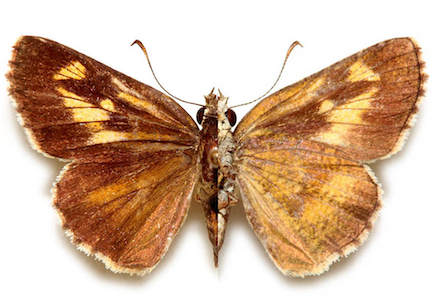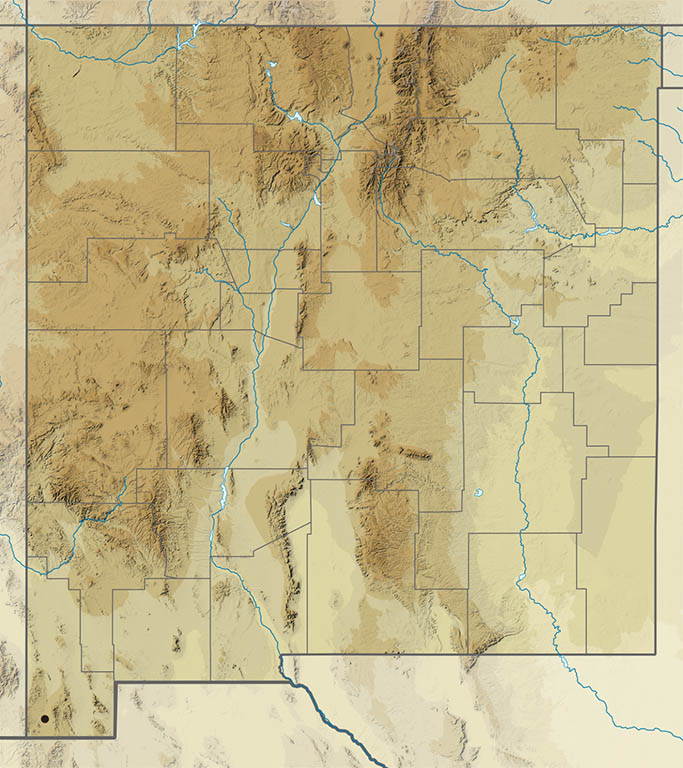By Steven J. Cary and Michael E. Toliver [This site is under construction.]
Skippers (Hesperiidae). About a third of our butterfly fauna, more than 100 species, belongs to this family, which is subdivided into six subfamilies in the US: Eudaminae, Tagiadinae, Pyrrhopyginae, Pyrginae, Heteropterinae, and Hesperiinae. Of those six subfamilies, five are known from New Mexico and the sixth (Tagiadinae, represented by Celaenorrhinus fritzgaertneri) has been taken on the Arizona side of Cottonwood Canyon, Peloncillo Mountains. Therefore, it is likely that eventually all six will be known from our state. The tribe Megathymini had until recently been considered a seventh subfamily, but genetics work by Li, et al. (2019) shows it belongs within the Hesperiinae. Skippers earned their name because of their rapid, skipping flight, which is powered by a heavily-muscled thorax. All skippers have antennal clubs that are distinctively bent, curved or hooked. Larvae silk leaves together for nests; larvae overwinter. Most subfamilies have characteristic larval food preferences. Updated November 30, 2022
Folded-Wing Skippers (Hesperiidae: Hesperiinae). This present chapter describes each of our 50+ known Hesperiine species. The vast majority are small, with wingspans of 1.5 inches or less, and with subtle marks. Some genera contain many similar species that pose challenges for identification. Adults typically rest with wings folded together over the back. When active, most perch with hindwings spread horizontally and forewings cocked half open, which is a challenge for photographers. Most Hesperiine larvae eat grasses and therefore are most prevalent in prairies, savannas and mountain meadows. The number and diversity of Hesperiines in any particular location generally speaks to the health of grassland ecosystems.
Other Grass-Skippers (Hesperiidae: Hesperiinae: Hesperiini). There are too many species of Grass Skippers to fit comfortably onto one PEEC webpage. In section VI-A we included the first 15 genera, which all belong to Tribe Hesperiini and Subtribe Hesperiina: the Branded Grass Skippers. Within Tribe Hesperiini, the remaining subtribes (Moncina, Apaustina, Thymelicina, Calpodina) and genera which occur in New Mexico are lumped for convenience here under Other Grass Skippers in Section VI-B. Updated November 13, 2025
- Nysa Roadside-Skipper (Amblyscirtes nysa)
- Common Roadside-Skipper (Amblyscirtes vialis)
- Bronze Roadside-Skipper (Amblyscirtes aenus) Amblyscirtes aenus erna, Amblyscirtes aenus megamacula
- Cassus Roadside-Skipper (Amblyscirtes cassus)
- Texas Roadside-Skipper (Amblyscirtes texanae)
- Slaty Roadside-Skipper (Amblyscirtes nereus)
- Dotted Roadside-Skipper (Amblyscirtes eos)
- Oslar’s Roadside-Skipper (Amblyscirtes oslari)
- Large Roadside-Skipper (Amblyscirtes exoteria)
- Orange-Headed Roadside-Skipper (Amblyscirtes phylace)
- Orange-edged Roadside-Skipper (Amblyscirtes fimbriata)
- Arizona Roadside-Skipper (Amblyscirtes arizonae) Amblyscirtes elissa
- Toltec Roadside-Skipper (Amblyscirtes tolteca prenda)
- Eufala Skipper (Lerodea eufala)
- Violet-clouded Skipper (Lerodea arabus)
- Ocherous Skipper (Lerema ochrius) Clouded Skipper, Lerema accius
- Garita Skipperling (Oarisma garita)
- Edwards’ Skipperling (Copaeodes edwardsii) Oarisma edwardsii
- Orange Skipperling (Copaeodes aurantiaca)
- Southern Skipperling (Copaeodes minima)
- Brazilian Skipper (Calpodes ethlius)
- Least Skipperling (Ancyloxypha numitor)
- Tropical Least Skipperling (Ancyloxypha arene)
- Sunrise Skipper (Adopaeoides prittwitzi)
- Ocola Skipper (Panoquina ocola)
- Faded Faceted-Skipper (Synapte shiva) Synapte syraces
Amblyscirtes nysa W. H. Edwards 1877 Nysa Roadside-Skipper (updated October 14, 2025)
Description. In this genus of tiny skippers, Nysa Roadside-Skipper is one of the most distinct species because the ventral hindwing is uniquely mottled with splotches of brown and pale gray. Wing fringes are checkered black and white. Uppersides are black-brown, with a few small forewing postmedian white spots. Range and Habitat. Amblyscirtes nysa is widespread in Mexico, extending north into southern Arizona, southern New Mexico, Oklahoma and much of Texas. In our state it prefers warm, grassy canyons and arroyos below 5500′ elevation (counties: Ch,DB,DA,Ed,Gr,Hi,Le,Ot?,Qu,Ro). Life History. Larval host grasses include Echinochloa muricata, Digitaria sanguinalis, Stenotaphrum secundatum, Setaria glauca, and Paspalum species. Flight. Although Nysa is multivoltine farther south, there are just two generations per year in New Mexico. The first flies from about May 6 to June 10; the second responds to summer/autumn rains and is on the wing between about July 11 and October 4. Males establish territories in sandy gully bottoms or sandy roadbeds; both sexes seek nectar. Comments. Hugh Avery Freeman gets credit for our first record of Amblyscirtes nysa, which he found near Tucumcari (Qu) on 11 July 1942.





Amblyscirtes vialis (W. H. Edwards 1862) Common Roadside-Skipper (updated October 14, 2025)
Description. On Amblyscirtes vialis, the upperside is black-brown with three tiny subapical white spots and occasionally a spot or two in the forewing postmedian area. The underside is black/brown, but heavily frosted with blue-white overscaling beyond the median area and a vague hindwing postmedian band. Wing fringes are distinctly checkered tan and brown. Range and Habitat. Common Roadside-Skipper occurs widely across temperate North America, including the central Rocky Mountains and northern New Mexico uplands (counties: Co,LA,Mo,RA,Sv,SF,Ta,Un). In our state it is a Transition Zone insect inhabiting grassy openings and draws in moist oak/pine woodlands between 6500 and 9000′ elevation. Life History. Larvae eat broad-bladed mesic grasses like Bromus lanatipes, Bromus inermis, Agropyron trachycaulum and Phleum pratense. Larvae overwinter. Flight. The single annual generation flies from May 7 to July 22, with maximum numbers in June. Adults are found in foothills and mountain meadows near streams. They perch on grasses and are fond of nectar. Comments. Our earliest report is from J. R. Merritt, who found it at Taos Pass (Ta) on 22 June 1955. Worn individuals can be difficult to identify due to lack of marks.




Amblyscirtes aenus W. H. Edwards 1878 Bronze Roadside-Skipper (updated October 27, 2025)
Description. Bronze Roadside-Skipper is gray-brown with coarse-checked, cream-colored fringes. Variable forewing spots are less orange than in Cassus Roadside-Skipper, but more orange than in Texas Roadside-Skipper; there is no forewing cell spot. Males lack an obvious stigma, which is present in the other similar skippers. Ventral hindwing spots are weaker than in Cassus, but stronger than in Oslar’s Roadside-Skipper. The forewing apex is more rounded than in Amblyscirtes oslari. Range and Habitat. This is our most widespread Amblyscirtes species (all counties except Le,Ro,SJ,Va). It occupies Upper Sonoran Zone and lower Transition Zone gulches and canyons, 5000 to 8000′ elevation. Bronze Roadside-skipper lives from Utah and Colorado south into Mexico. Life History. Bailowitz and Brock (2021) listed a variety of grasses as larval hosts for this species in southeast Arizona: Bouteloua curtipendula, Bromus anomalus Sorghum halapense, Digitaria californica, Digitaria sanguinalis, Setaria leucopila, and Eragrostis curvula (Poaceae). Brock (1993) also confirmed use of Echinochloa crusgalli there. Larvae use Agropyron ambiguus in Colorado (Scott 1992). Larvae hibernate. Flight. Amblyscirtes aenus is single-brooded in northeast New Mexico, peaking in May. It is univoltine at higher sites, peaking in June – July. It is bivoltine in southern New Mexico peaking in May and again in July to August. Extreme dates are April 3 and September 30. Adults come to flowers; males defend arroyo-bottom and canyon-bottom territories. Comments. Most of our records are probably the nominate subspecies, but observations from the Eastern Plains may well be Amblyscirtes aenus erna H. A. Freeman 1943, which has much fainter ventral HW spots; there are records of this subspecies from Guadalupe Mountains National Park, just south of Carlsbad Caverns National Park. It also is possible that specimens from the far southwest part of NM (the “Bootheel”) are Amblyscirtes aenus megamacula J. Scott 1998, which has larger, more prominent spots on the VHW.





Amblyscirtes cassus W. H. Edwards 1883 Cassus Roadside-skipper (updated October 15, 2025)
Description. Cassus is our orangest Amblyscirtes species. Its forewing upperside is brown with orange spots, including a prominent cell spot. Fine, dense, black and white striations create a grizzled appearance on the hindwing underside, with vague pale median and post-median bands. Wing fringes are checkered black and white. When worn, it can be confused with Bronze Roadside-Skipper. Range and Habitat. Amblyscirtes cassus has a classic southwestern distribution that includes northern Mexico, west Texas, Arizona and New Mexico (counties: Ca,Ci,Co,Gr,Hi,Li,LA,MK,Ot,RA,Sv,SM,SF,Si,So). It prefers pine woodlands and savannas having lots of understory grasses, 5400 to 9200′ elevation. Reports are sparse at its northern limits in north-central New Mexico. Life History. Bailowitz and Brock (2021) reported that the primary host in SE AZ is Zuloagaea bulbosum (Poaceae). Oviposition has been observed on Dactylis glomerata; other grasses are also suspected as larval hosts. Flight. Adults fly in a single summer generation, May 20 to August 26, peaking in July. Adults come to nectar (e.g., Vicia) and water, often in riparian situations. Males establish territories on forest roads. Comments. F. H. Snow collected the first New Mexico specimen in Gallinas Canyon near Las Vegas (SM) in August of 1882.



Amblyscirtes texanae E. Bell 1927 Texas Roadside-Skipper (updated October 15, 2025)
Description. Compared to Bronze Roadside-Skipper, with which it is often confused, Texas Roadside-Skipper is less colorful. There is no orange on any wing surface. Forewing spots, including a cell spot that is absent in Bronze Roadside-Skipper, are cream-colored. Wing fringes are checkered white and tan. Range and Habitat. Like many of its sister species, Amblyscirtes texanae occurs from Arizona, New Mexico and Texas south into northern Mexico, preferring Lower and Upper Sonoran Zone rocky canyons. In our state it occurs lower in the landscape than other canyon-patrolling roadside-skippers, usually 3500 to 6000′ elevation (counties: Ca,Ch,Ci?),DA,Ed,Gr,Gu,Hi,Le,Lu,Ot,Qu,Si,So). Life History. Bionomics of this species are poorly known, but Brock (1993) confirmed Zuloagaea bulbosum (Poaceae) as a larval host in southeast Arizona. Flight. Adults fly in two annual generations here. Extreme dates are April 28 and August 26, but maximum numbers are in May and again in July. Males establish gully-bottom territories and defend them from prominent rocks. Adults like nectar and moist soil. Hot afternoons may be spent perched head-upward on shaded, vertical walls. Comments. Our northernmost report (Ci) may represent a stray. Our oldest report is from near Tucumcari (Qu) on 25 August 1941 by H. A. Freeman.





Amblyscirtes nereus (W. H. Edwards 1876) Slaty Roadside-Skipper (updated October 15, 2025)
Description. The olive-cream-gray ventral hindwing of Slaty Roadside-Skipper is unique. Against this background, underside pale spots may seem indistinct. Dorsal spots are prominent against a slate gray ground; there is no cell spot on the forewing upperside. Range and Habitat. The limited geographic distribution of this skipper includes southeast Arizona, the northern Sierra Madre of Mexico, west Texas and southern New Mexico (counties: Ca,Ed,Gr,Hi,Lu,Si). It inhabits Upper Sonoran Zone canyons in our larger desert mountain ranges, usually below 6000′ elevation, but occasionally up to 8000′. Life History. Butterflies of America website shows a caterpillar on Bothriochloa barbinodis (Poaceae). That species (Cane Bluestem) is widely distributed across the SW US. Flight. Adult Slatys mostly fly during the summer monsoons: July 2 to August 23. There is a partial or occasional spring brood in southeast Arizona (Bailowitz and Brock 1991) and SW NM (May 25). Males patrol up and down foothill canyons, often stopping for refreshment at flowers or moist earth. Comments. Differentiating the various Roadside-Skippers presents a never-ending, yet fascinating, challenge. To learn them, go to a place where two different kinds fly together and study their appearance, variability, and behaviors.





Amblyscirtes eos (W. H. Edwards 1871) Dotted Roadside-Skipper (updated October 30, 2025)
Description. Tiny, Dotted Roadside-Skipper is gray-brown below with dark-rimmed white dots arranged in a hindwing postmedian band and a basal pair. In comparison, Amblyscirtes arizonae [formerly elissa] and A. tolteca prenda lack the dark rims. Dotted R-S is dark gray to black above with postmedian white spots on the forewing. Fringes are checkered, especially the hindwing, which also distinguishes Dotted from Arizona and Toltec roadside-skippers, both of which have reduced checkering. Range and Habitat. Amblyscirtes eos occurs in Arizona, Colorado, New Mexico, Oklahoma, Texas and northern Mexico. It inhabits Upper Sonoran Zone grasslands, preferring disturbed sites. It is widespread in our state below 8000′ elevation, but absent from moist mountains (all counties except Ca,Ci,LA,MK,RA,SJ,Ta). Life History. Bailowitz and Brock (2021) reported Hopia obtusa (Poaceae) as the only known larval host. Flight. Dotted Roadside-Skipper has one to two extended annual broods. In southern New Mexico there are flight peaks in April to May and again in August, with extreme dates of March 20 and September 29. Northern New Mexico records span April 30 to August 31 with a peak in June. Adults perch on the ground in swales and come to nectar. Comments. In 1911, H. Skinner described Pamphila quinquemacula from Las Cruces (DA). Characterized by a much-reduced spot pattern on the underside, it is now considered a junior synonym of Amblyscirtes eos.




Amblyscirtes oslari (Skinner 1899) Oslar’s Roadside-Skipper (updated October 15, 2025)
Description. Compared to Bronze Roadside-Skipper, Oslar’s Roadside-Skipper has a fairly uniform pale gray ventral ground color and semi-prominent spotting on all wings. The forewing apex is more pointed than in sister species. Fringe checkering is negligible. Worn individuals are a challenge to identify. Range and Habitat. This skipper lives east and south of the Rocky Mountains from Saskatchewan south to Arizona, New Mexico and Texas. It is widespread in New Mexico grasslands, 4500 to 8000′ elevation (all counties but Cu,DB,Gu,Le,Lu,Ro,SJ,Si). Life History. Larvae of Amblyscirtes oslari prefer to eat Bouteloua curtipendula, but seem to tolerate Andropogon scoparius and Andropogon gerardii (all Poaceae) (Scott 1992). Flight. One extended generation spans April 21 to August 6, peaking in June. Males patrol low grassy areas and arroyos. Adults appreciate fine nectar. Comments. Southern New Mexico records suggest an early brood in late April to May and a second brood in late July during the summer monsoon. John Woodgate collected our first specimens, in the Jemez Mountains in 1913.





Amblyscirtes exoteria (Herrich-Schäffer 1869) Large Roadside-Skipper (updated October 15, 2025)
Description. Though still small, this our largest Amblyscirtes species has a grizzled, dark gray-brown ground color above and below, with widely separated small white spots. There also is a spot in the forewing cell. Wing fringes are whitish with gray checks. There may be a brassy cast to the upperside. Range and Habitat. Large Roadside-Skipper is of Sierra Madrean affinity, but its range extends north to the Mogollon Rim of Arizona and New Mexico (counties: Ca,Gr,Hi,Si). In our state it occupies Upper Sonoran grasslands and open woodlands, 5200 to 8200′ elevation. Life History. Brock (1993) confirmed Muhlenbergia emersleyi (Poaceae) as a host in southeast Arizona and it is probably used in New Mexico as well. Flight. Amblyscirtes exoteria completes one generation per year with adults on the wing during the monsoon season; early and late dates are July 1 and August 20. Adults prefer canyons or riparian situations where they sip nectar and moist earth, sometimes flying in semi-shade on hot afternoons. Comments. Our first New Mexico report came from John P. Hubbard, Pinos Altos Mountains (Gr), 5-8 July 1958; that specimen is in the Allyn Museum of Entomology.





Amblyscirtes arizonae H. Freeman, 1993 Arizona Roadside-Skipper (updated October 30, 2025)
Description. Dorsally, Arizona Roadside-Skipper is dark brown with the typical “roadside” white apical spots on the forewing. A small round white spot is present lower in the forewing cell, distinguishing this species from both the Toltec Roadside Skipper (which has a large hourglass-shaped spot in the cell) and the Dotted Roadside Skipper (whose forewing cell is spot-less). Ventrally, there is a prominent series of postmedian small white spots on the hindwing which are not outlined in black. As this species closely resembles the two afore-mentioned roadside-skippers, close examination is required to be certain of your identification. Range and Habitat. Arizona Roadside-Skipper barely enters the US in SE AZ and SW NM (Hi). Its main range is farther south. Life History. According to Bailowitz & Brock (2021), the only recorded larval host is Bouteloua curtipendula, Side-oats Gramma. Flight. In NM, our few records are from the monsoon season (July – September). This mirrors its occurrence in SE AZ. Comments. Formerly considered a subspecies of Amblyscirtes elissa, Zhang et al., (2020) elevated Amblyscirtes arizonae to species status based on its DNA. The species was considered a very rare find in the US, but it has increased in numbers since the 1990s. We seek more photos to illustrate this species. Any you are willing to share will be gratefully received and credited.


Amblyscirtes tolteca Scudder 1872 Toltec Roadside-Skipper (updated October 15, 2025)
Description. Toltec Roadside-Skipper is dark brown on the upperside, with pale spots on both wings. The hourglass-shaped spot in the forewing cell and the pale spots on the upper surface of the hindwing distinguish this species from similar roadside-skippers. Beneath, Toltec is brown with grey overscaling. The pale spots are repeated, with a distinctive spot in the middle of the trailing margin of the hindwing, absent in other roadside-skippers. Range and Habitat. This species is found in southeast Arizona and extreme southwest New Mexico (county: Hi), then south into Mexico. Life History. Toltec larvae eat a variety of grasses in MX, but their food source in the US remains to be determined. In MX, they eat Pennisetum oilare, Setariopsis auriculata, Urochloa fusca, and Dinebra panicea (Bailowitz & Brock 2021) Flight. In southeast Arizona, the species flies from May to September, with most records centered around Labor Day (Bailowitz & Brock, 2021). Similar habits can be expected in New Mexico. Comments. Our subspecies is Amblyscirtes tolteca prenda Evans 1955, formerly considered a separate species.






Amblyscirtes phylace (W. H. Edwards 1878) Orange-headed Roadside-skipper (updated October, 2025)
Description. What’s in a name? “Orange-Headed Roadside-Skipper” says almost all you need to know (but note A. fimbriata below). Amblyscirtes phylace is slate gray to glossy black on all wing surfaces, with cream-colored wing fringes. The head and palps are orange, more so even than on Dun Skipper, with which it may sometimes fly. Also, Dun Skipper is larger, browner, and its fringes are dark brown like the wings. In comparison to the Orange-edged Roadside Skipper, Orange-headed has cream fringes and a more pointed forewing. Males have shorter stigmas than does Orange-edged. Range and Habitat. Amblyscirtes phylace lives in grassy gullies and canyons in ponderosa pine savannas in Colorado, Arizona, New Mexico and west Texas. In our state it inhabits major mountain ranges (counties: Be,Ca,Ci,Co,Gr,Li,LA,MK,Mo,Ot,RA,Sv,SM,Si,So,To,Un), usually from 6000 to 9200’ elevation. Life History. In Colorado the preferred larval host is big bluestem (Andropogon gerardii), but side-oats grama (Bouteloua curtipendula) is sometimes used (both Poaceae). Flight. This handsome skipper completes one generation per year, with adults about from May 19 to July 30, primarily in June. Males perch on gully banks and patrol up- and downstream, chasing interlopers and courting females. Adults feed at flowers and damp soil. Comments. When worn, Orange-Headed Roadside-Skipper can be confused with its orange-fringed Mexican counterpart, Amblyscirtes fimbriata (Plötz 1882). It would be nice to add that latter species to our state’s butterfly fauna, so specimens from far southwest New Mexico should be examined closely to ensure proper identification. There is an unconfirmed report of the Orange-edged Roadside Skipper from the Animas Mountains (Hi).





Amblyscirtes fimbriata (Plotz 1882) Orange-edged Roadside-Skipper (updated May 8, 2023)
Description. A virtual look-alike to the Orange-headed Roadside Skipper, except for the obvious orange fringes. The upper side is glossy black or dark brown, with orange head and fringes. Worn specimens may have that fringe reduced or absent, complicating identification. Orange-edged has more rounded front wings than Orange-headed, and the male stigma (if visible) is longer. Range and Habitat. In the US, this species is limited to extreme SE AZ and (possibly) extreme SW NM. Otherwise, it is a Mexican species. Life History. Larvae eat Bromus inermis, B. anomalus and Elymus arizonicus in SE AZ (Bailowitz & Brock 2022). Flight. In SE AZ, the species occurs from May to August. Comments. Brock & Kaufman (2003) state “Only in Chiricahua and Huachuca Mountains, and Animas Mountains, New Mexico.” The latter report needs verification but does make biogeographic sense. Some fortunate enthusiast will verify this report some day! We seek more photos to illustrate this species. Any you are willing to share will be gratefully received and credited.


Lerodea eufala (W. H. Edwards 1869) Eufala Skipper (updated May 15, 2025)
Description. Eufala is a small, gray-brown skipper, that approaches nondescript. It is slightly darker above than below, with arcs of white median and postmedian spots on the forewing. There are several nondescript skippers which might be confused with Eufala, some of which may appear in NM. Nastra julia (H. Freeman 1945; Julia’s Skipper) is one such, though unlikely. Range and Habitat. Eufala breeds in Pacific coastal areas of California and Mexico, and in Atlantic coastal areas from Mexico to the Carolinas. Its occasional appearance in New Mexico (counties: Be?,Ci,DA,Ed,Gr,Hi,Le,Lu,Ot,Ro,Ta) has been considered accidental because there is no evidence of breeding here. When found, it is usually at low elevation (3800 to 5500′) in nectar-rich, damp areas as are usually frequented by strays. Life History. Lerodea eufala breeds year-round in its more southerly coastal homes where larvae eat various grasses (Scott 1986), including exotics like Zea mays (corn), Sorghum species and Saccharum species (sugar cane). Flight. New Mexico has several scattered historical records of Eufala, typically from July 19 to December 18, during and after the summer monsoon. In recent years, however, this bland little skipper has become almost regular in the Las Cruces area.




Lerodea arabus (W. H. Edwards 1882) Violet-clouded Skipper (updated October 15, 2025)
Description. Much like Eufala in appearance, Violet-clouded may be distinguished by the dark postmedian patch on the ventral hindwing and the more prominent white spot below the cell on the forewing. Range and Habitat. Formerly a rare insect in the American SW, it appears to be more common recently in SE AZ during the monsoon season. In NM, there are only two records: an historical one from Doña Ana County and a recent sighting from Grant County (see photo below). Life History. Caterpillars eat grasses including Echinochloa crus–galli, Cynodon dactylon and Otatea acuminata in SE AZ and MX (Bailowitz & Brock 2021). There is as yet no evidence of reproduction in NM. Flight. In AZ, records span Feb. to Dec. The summer monsoon season would be a logical time to look for this species in NM. Comments. Because of its resemblance to other smaller dark skippers, Violet-clouded is easily overlooked. Watchers in southern NM should be on the lookout!

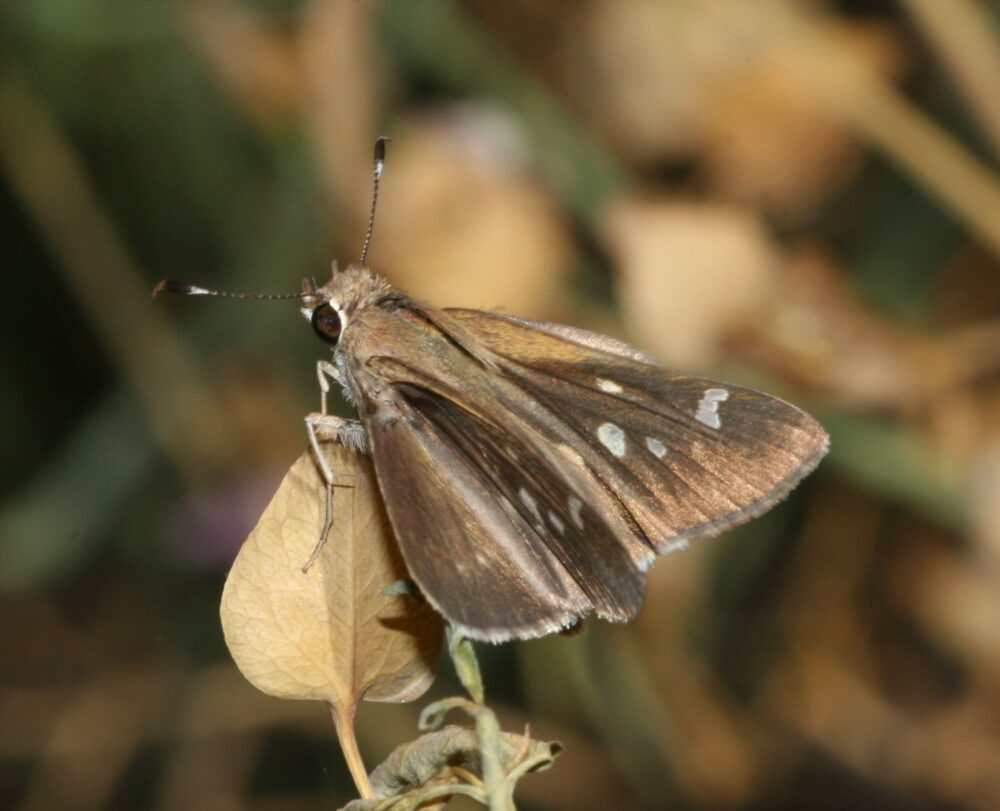
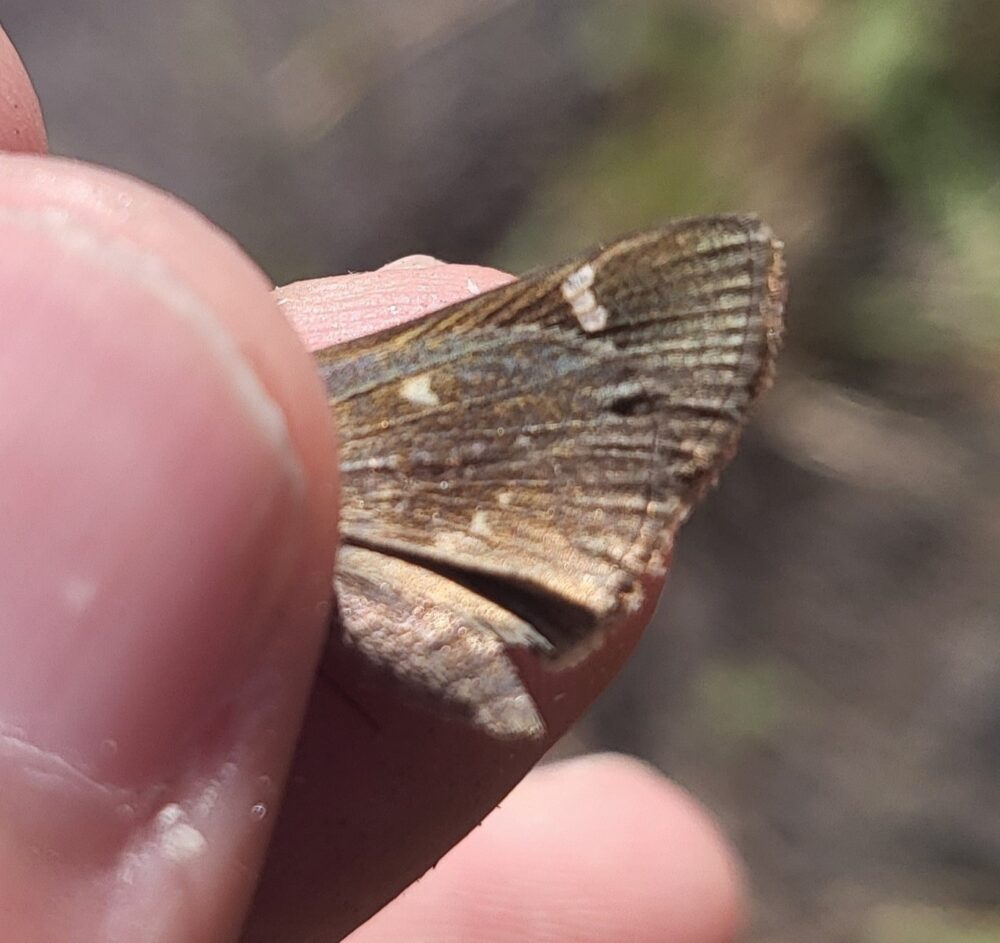
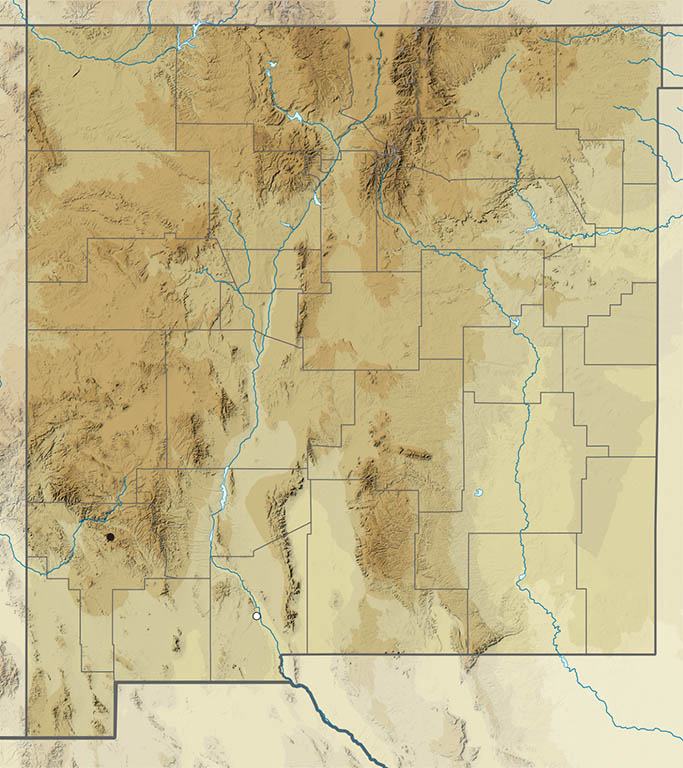
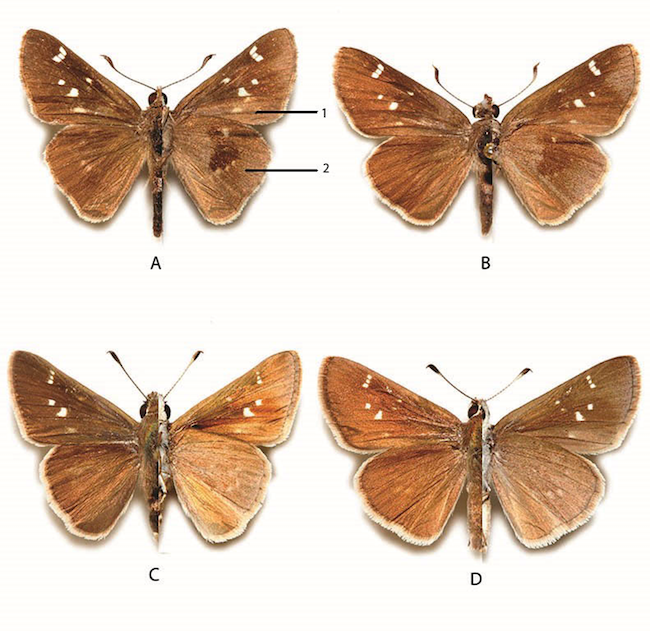
Lerema ochrius Grishin 2023 Ocherous Skipper (updated October 15, 2025)
Description. Ocherous Skipper males are dark brown dorsally, with three subapical white spots on the forewing and usually a small white spot just below. There is an obscure black stigma below the FW cell. Females have more white spots on the dark brown forewing upperside, including one in the cell. Ocherous Skipper was recently separated from Clouded Skipper (Lerema accius [J. E. Smith 1797]) and is difficult to distinguish from that species. Apparently, Clouded Skippers are mostly eastern US in distribution (though it has been taken in Big Bend NP), while western individuals are Ocherous. The two species can only be reliably differentiated through DNA analysis, though there are some morphological differences to look for. Generally, Ocherous is yellower ventrally than Clouded. There are differences in larval morphology as well. Range and Habitat. Lerema ochrius is currently known only from south and west TX, with strays to AZ and NM. It may be a rare visitor to wet oases along our southern border (counties: Ed,Hi). Life History. In the original description (Zhang, et al, 2023), the life history is illustrated (egg through mature larva) and the host is described as “a variety of grasses.” Flight. We find it here very rarely in late summer and autumn; our few records span September 13 to November 20. It cannot survive New Mexico winters. Comments. The Ocherous Skipper was first seen here at Rattlesnake Springs (Ed) in 1986. Back then we called it Clouded Skipper, but now we think we know better.




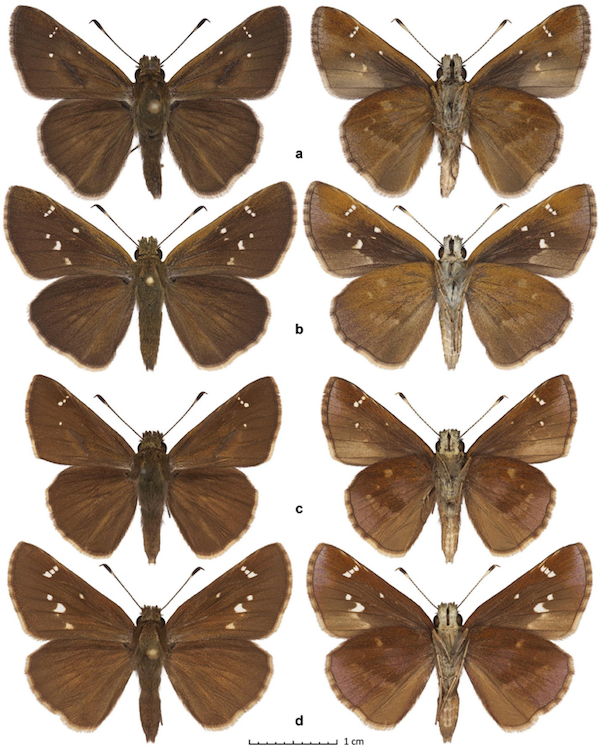
Oarisma garita (Reakirt 1866) Garita Skipperling (updated October 15, 2025)
Description. Oarisma garita is very small, about the size of dime in terms of wingspan. Our single species, Garita Skipperling, has an orange upperside, but the orange is usually hidden by heavy, black overscaling, creating a dark, ‘burnt’ orange look. The hindwing is frosted gold below, with distinctly white veins and gray/silver fringes. Least Skipper (Ancyloxypha numitor) has similar markings below, but its upperside is quite different and wings are more rounded. Range and Habitat. Oarisma garita lives from the Mexican Sierra Madre northward in the Rockies as far as southern Canada. It is the most boreal of our tiny Hesperiine skippers, living in Transition and Canadian Zone meadows from 8,000 to 11,000′ elevation in our major uplands (counties: Be,Ca,Ci,Co,Gr,Li,LA,MK,Mo,Ot,RA,Sv,SM,SF,Si,So,Ta,To,Un). Life History. Grasses (Poaceae) and sedges (Cyperaceae) are hosts for larvae. After listing several bunch, turf and hay grasses, noted butterfly ecologist James A. Scott called Oarisma garita “the most polyphagous monocotyledon-feeding skipper known.” Flight. Adult Garita fly in alpine meadows, often coming to nectar. Its primary annual flight spans May 15 to August 26, peaking in July. A second flight (September – October 8) sometimes occurs in the Gila high country following a productive monsoon. Comments. Zhang, et al (2019) suggested that Oarisma and Copaeodes were subgenera, with the proper generic name being Oarisma. Pelham (2023) argued that the two names could be regarded as separate genera as long as “Oarisma” edwardsii (Reakirt) was transferred to Copaeodes. For now, we follow Pelham. An old New Mexico specimen in the American Museum of Natural History is labelled “Rincon, 25 June 1898.” The name “Rincon” is of colonial Spanish origin and could refer to many different New Mexico places (Julyan 1996). Habitat preferences and popular collecting localities of that time suggest it was probably taken north of Las Vegas (SM), not in the present community of Rincon in northern Dona Ana County.
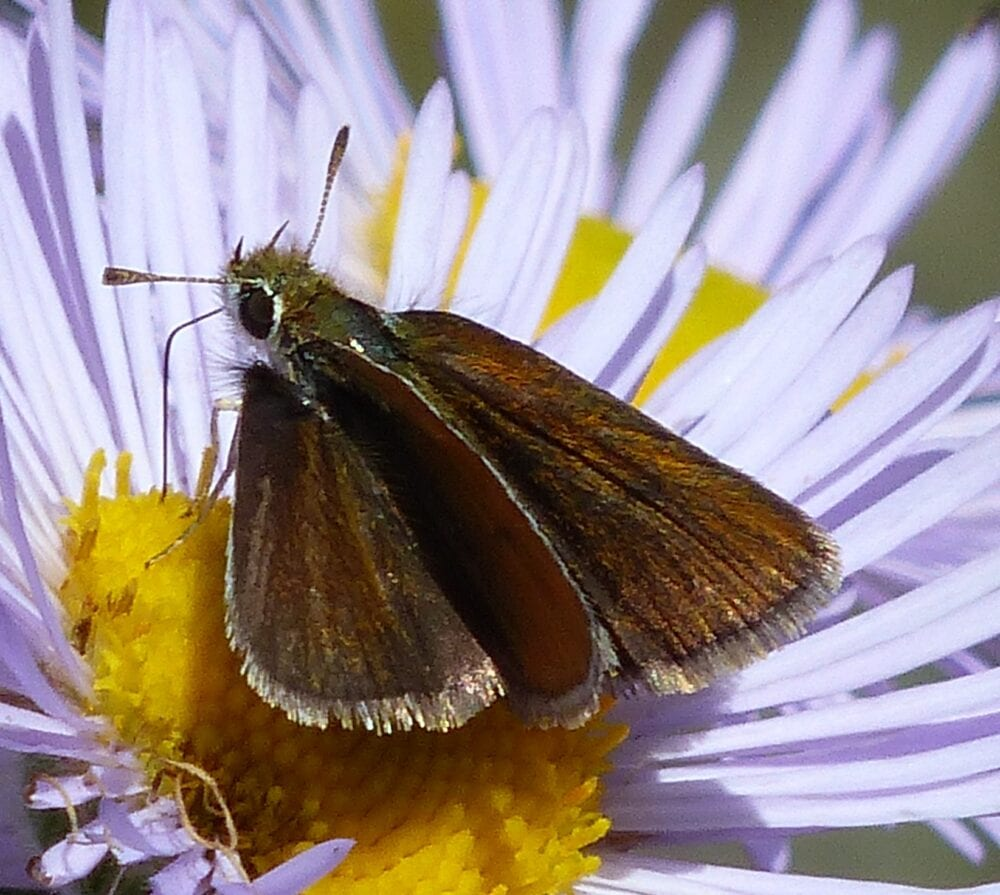
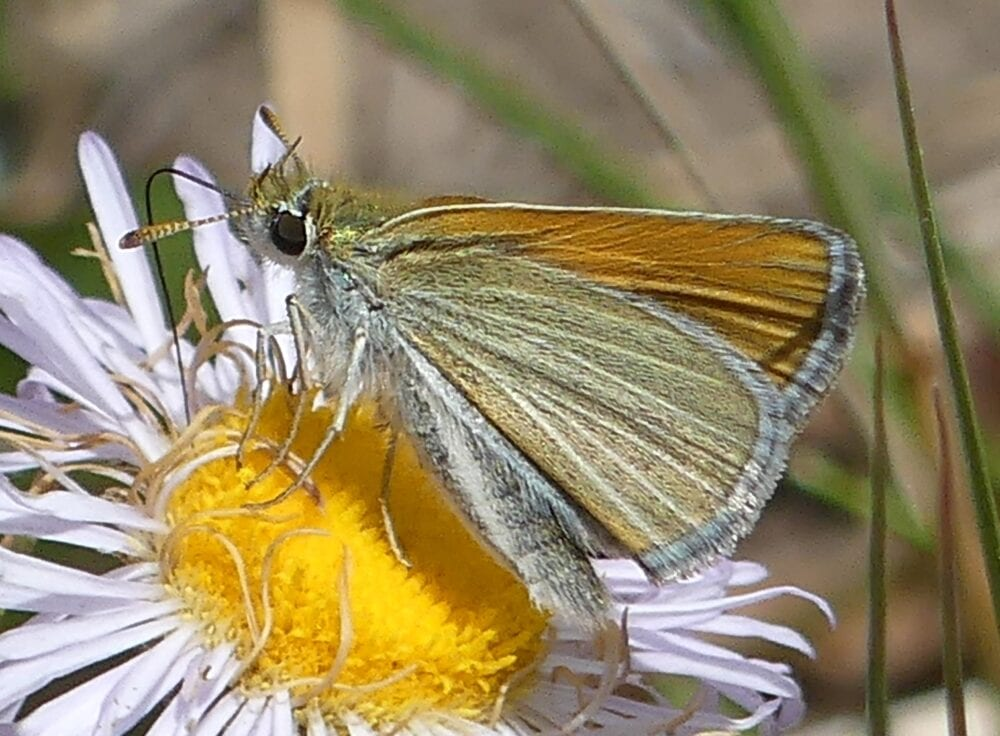
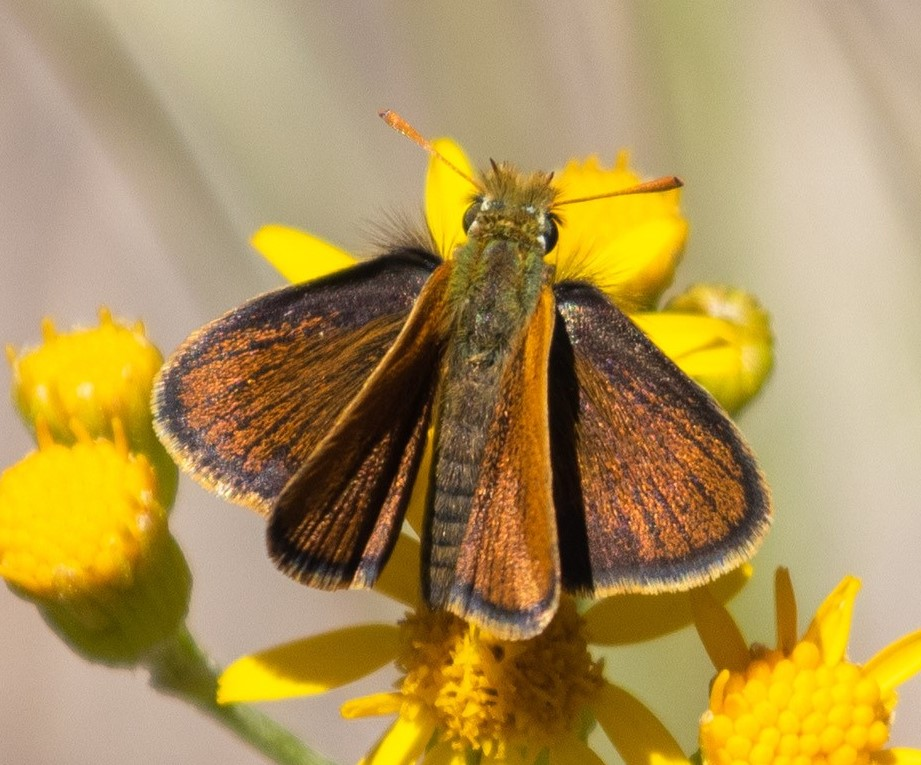


Copaeodes edwardsii (W. Barnes 1897) Edwards’ Skipperling (updated October 15, 2025)
Description. Skippers in this genus are dime-sized. Copaeodes edwardsii is much like the Oarisma garita, but the dorsal orange wing surfaces are unmasked by dark overscaling and the orange color shows prominently. The hindwing below is matte grey-gold, aging to grizzled, and lacks white on the veins. Viewed from below, the hindwing fringe is silver-gray rather than Garita’s white, but this difference is subtle. Range and Habitat. Edwards’ Skipperling is at home in Upper Sonoran and Transition Zone grasslands from Mexico north into central Colorado. In New Mexico it prefers high prairie arroyos and foothill canyons between 4500 and 8000′ elevation, but it has been found as high as 9200′ (all counties except Cu,DB,Gu,Le,Qu,Ro,SJ). Life History. Larval hosts in the region remain, but they must be grasses (Poaceae) or sedges (Cyperaceae) of one kind or another. Flight. We have one generation per year in most of New Mexico. Peak flight is in July in northern New Mexico, but August in southwest New Mexico. In the Mogollon and Guadalupe Mountains (Ca,Ch,Ed) there are two broods: May to July and again in September-October. Extreme dates are May 2 and October 8. Adults seek nectar at flowers (e.g., Apocynum, Allium). Males patrol drainages, but not strongly, and will come to moist soil. Comments. Copaeodes edwardsii usually flies lower on the mountain than does Oarisma garita, but they are sometimes found flying together in mid-elevation meadows and care must be exercised to tell one from the other.


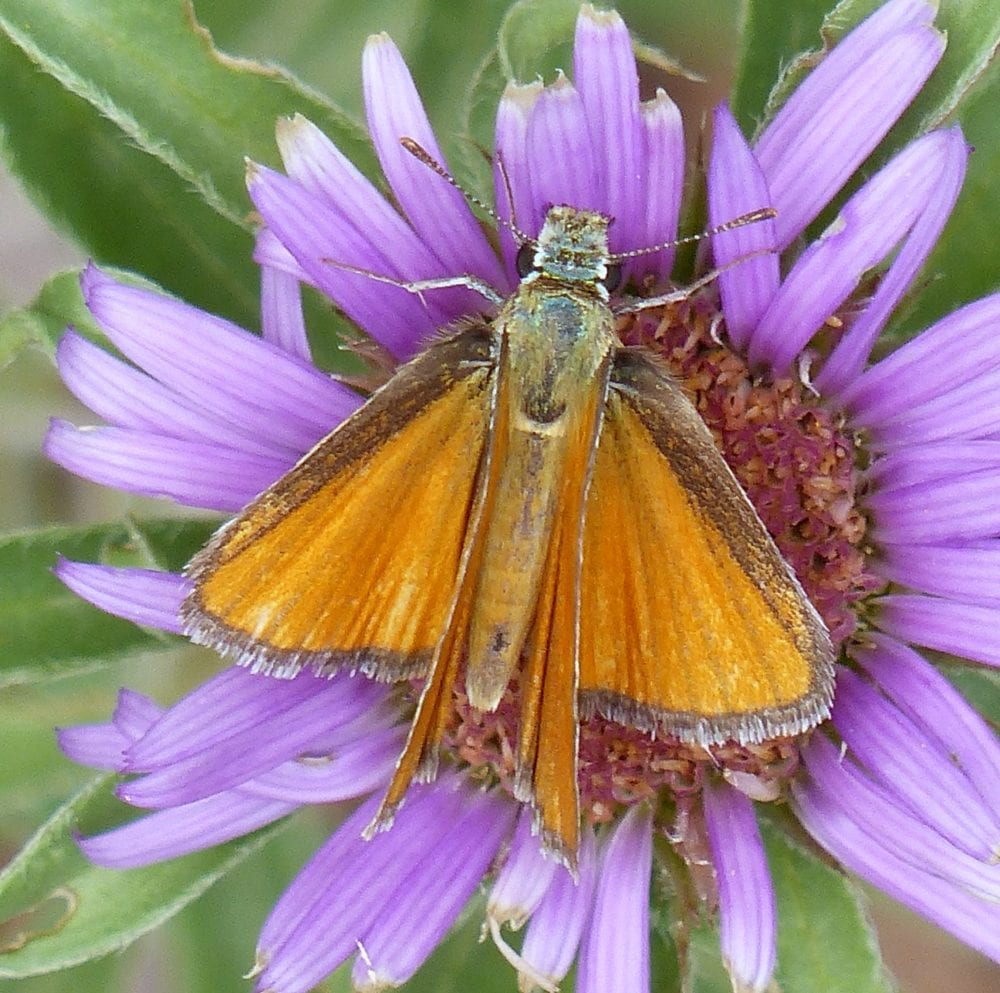

Copaeodes aurantiaca (Hewitson 1868) Orange Skipperling (updated October 15, 2025)
Description. On tiny Orange Skipperling, all wing surfaces are some bright hue of orange, with black scaling limited to basal portions of the ventral forewing, and of the ventral and dorsal hindwing. There is a thin black stigma on the male. The ventral hindwing is unmarked, a key character when separating Orange Skipperling from the closely related Southern Skipperling. Range and Habitat. Distributed northward from Central America, Copaeodes aurantiaca bumps against its northern limit in New Mexico. In our state it is resident throughout our Upper Sonoran Zone desert and foothill washes and arroyos below 6000′ elevation (counties: Be,Ca,Ch,Ci,Cu,DB,DA,Ed,Gr,Gu,Ha,Hi,Le,Li,Lu,MK,Ot,Qu,Ro,SM,SF,Si,So,To,Un,Va). Life History. Bailowitz and Brock (2021) reported that larvae eat various grasses. Cynodon dactylon is favored in urban areas. In natural areas, Bouteloua curtipendula (sideoats grama) and Disakisperma dubia are the predominant hosts in southeast Arizona. Muhlenbergia dumosa (bamboo muhly) also is used there (Brock 1993). Flight. Blithely unaware of their small stature, males establish and aggressively defend territories in gullies and washes. They perch alertly on rocks or stems and dart after all intruders, often returning to the same perch. Observations in New Mexico span March 6 to November 23. A spring generation peaks in April, then overlapping broods surge in late summer. Two broods fly in northeast New Mexico. Adults seek nectar. Comments. Though not yet reported from New Mexico, butterfliers should keep an eyeball peeled for the similar Copaeodes minima (W. H. Edwards 1870) along our southern border. It has a white streak on the hindwing below.


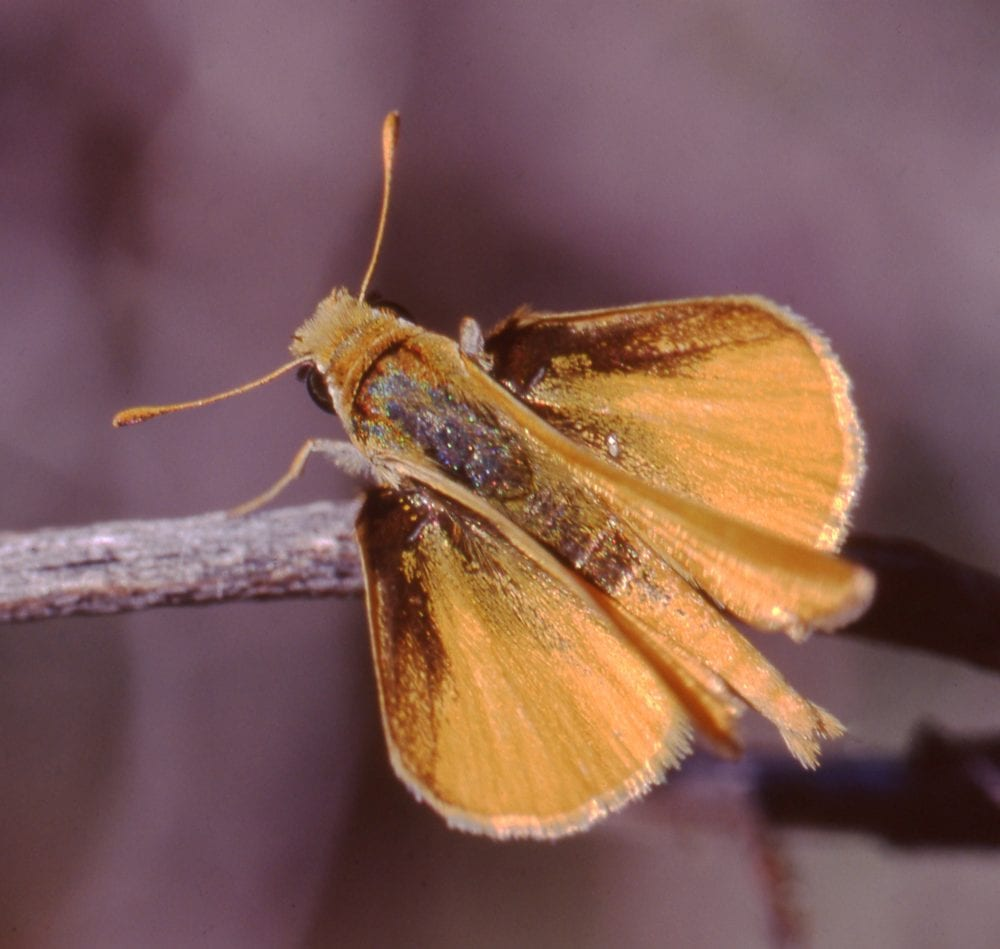

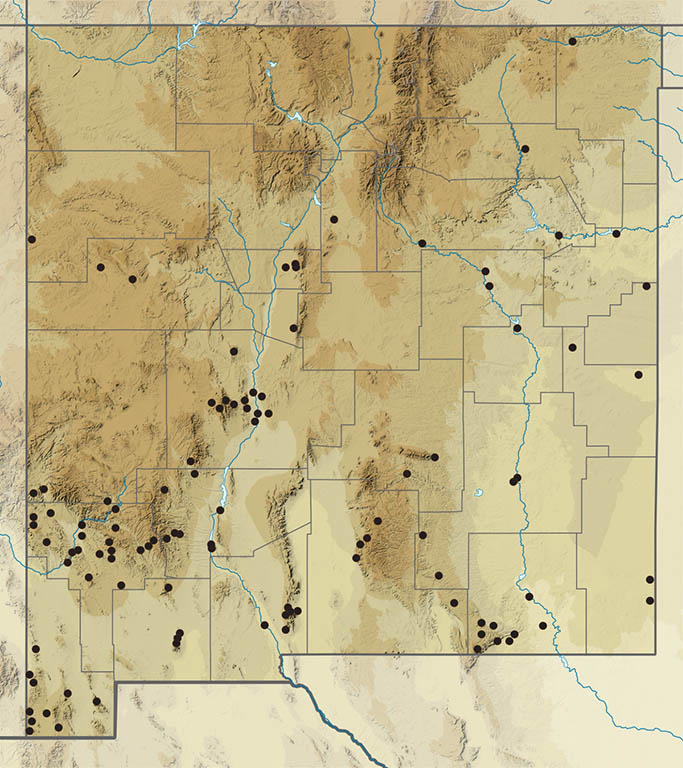
Copaeodes minima (W. H. Edwards 1870) Southern Skipperling (updated October 15, 2025)
Description. This is perhaps the smallest skipper in the US. It is a twin to the Orange Skipperling, except for the pale line running transversely from the VHW base to the margin. In that, it resembles the Sunrise Skipper (Adopaeoides prittwitzi), but that species has marginal darkened veins on the dorsal surface of both wings. Some individuals of Tropical Least Skipper (Ancyloxypha arene) also have a pale VHW line, and such individuals are much more difficult to distinguish from the Southern Skipperling if one only sees the ventral surface. At least some A. arene have marginal dark ends to the VHW veins, which C. minima lacks. A. arene also has dark marginal borders on the upperside of both wings, unlike minima, and its FW is more rounded. Range and Habitat. This is a species of the SE US along the Gulf and Atlantic coasts. South of the border, it ranges down to Panama. From its Mexican range, wanderers and occasional residents appear in southeast AZ and possibly southwest NM. Life History. In Mexico, larvae are known to eat Cynodon dactylon (Bailowitz & Brock 2021). Flight. Most records in southern AZ occur from August to October, coinciding with the traditional monsoon. There are a few spring records. Comments. There is one possible record of this species from Hidalgo County, about 3 miles N. of Rodeo along NM Hwy 80, from 20 October 2021. This little skipper has been confirmed within 12 miles of the NM border in San Bernardino National Wildlife Refuge, AZ. It may be easily overlooked due to its resemblance to the Orange Skipperling. We need live action photos of this tiny skipper. Do you have one to share? We’ll gratefully credit the photographer.


Calpodes ethlius (Stoll 1782) Brazilian Skipper (updated October 15, 2025)
Description. Brazilian Skipper is noticeably large as skippers go, with an elongated forewing. Upper wing surfaces are brown with several prominent white spots. On the underside, the brown ground color is redder but with the same spot pattern. Range and habitat. This skipper is native to coastal Mexico and South America. Its traveling habits have carried it as far north as New York. It is but a rare stray to New Mexico (counties: DA,Lu,Ot,Ro). Life history. Larvae eat Canna species (Cannaceae), none of which are native to New Mexico. However, Canna is a common ornamental and thus a wandering Brazilian Skipper female could find a safe harbor for her offspring in such plantings. Look for folded-over leaf pieces tied with silk to find the larvae. Kilian Roever found larvae on Canna in Deming. Flight. Our records are from mid-August to mid-October. Comments. Migrants occasionally produce a couple of late summer broods in southeast Arizona on ornamental Cannas, so it might be more frequent in southern New Mexico than available evidence suggests. Adults are fond of nectar. Our first specimen, taken in Portales (Ro) on 18 October 1966 by M. Franko, has been curated in Eastern New Mexico University’s excellent natural history collections.
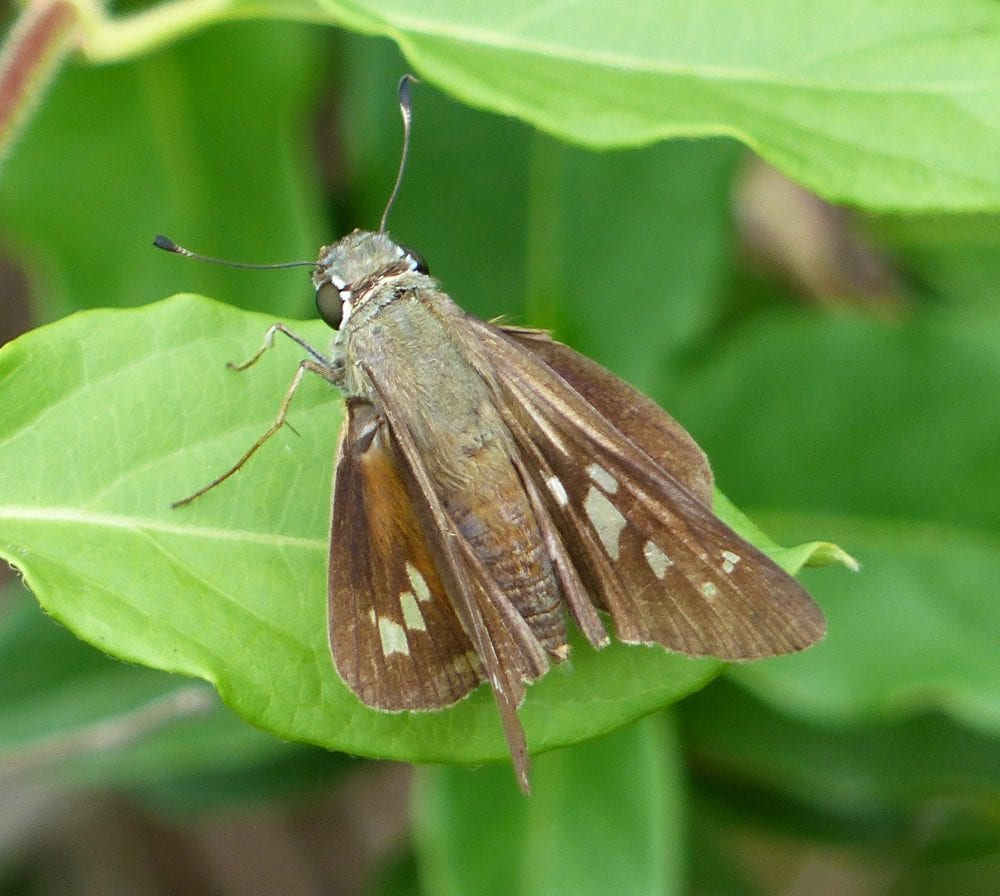

Ancyloxypha numitor (Fabricius 1793) Least Skipper (updated October 16, 2025)
Description. Very tiny, Least Skippers are orange above with black borders. The hindwing is gold below, but the forewing underside is gray-black with an orange border. Range and Habitat. This Great Plains and eastern US butterfly barely enters New Mexico in our extreme northeast corner (county: Un) in streamside habitats including Seneca Creek below Clayton Lake. Life History. Larvae eat broadleaf grasses. Scott (1992) cited Agropyron repens, Phalaris arundinacea, Bromis inermis, and Echinochloa crusgalli. Larvae roll grass leaves for shelter. Flight. Adults fly from late June to September 4, in two overlapping broods. In their habitat they dodge methodically among dense reeds, occasionally perching and nectaring. Comments. Steve’s first experience trying to photograph Ancyloxypha numitor below the dam at Clayton Lake State Park went like this: He waded, then waited, in mud to his knees. Adults flapped lazily, unconcernedly, dodging among stems of the tall grasses. They occasionally perched an arm’s length away. When Steve eased in for a photo, his elbow touched a grass stem, which pushed against another stem, whose shadow fell across the skipper, which flew away. Repeat. Makes a person appreciate the photographic skills of Bryan Reynolds, see below.
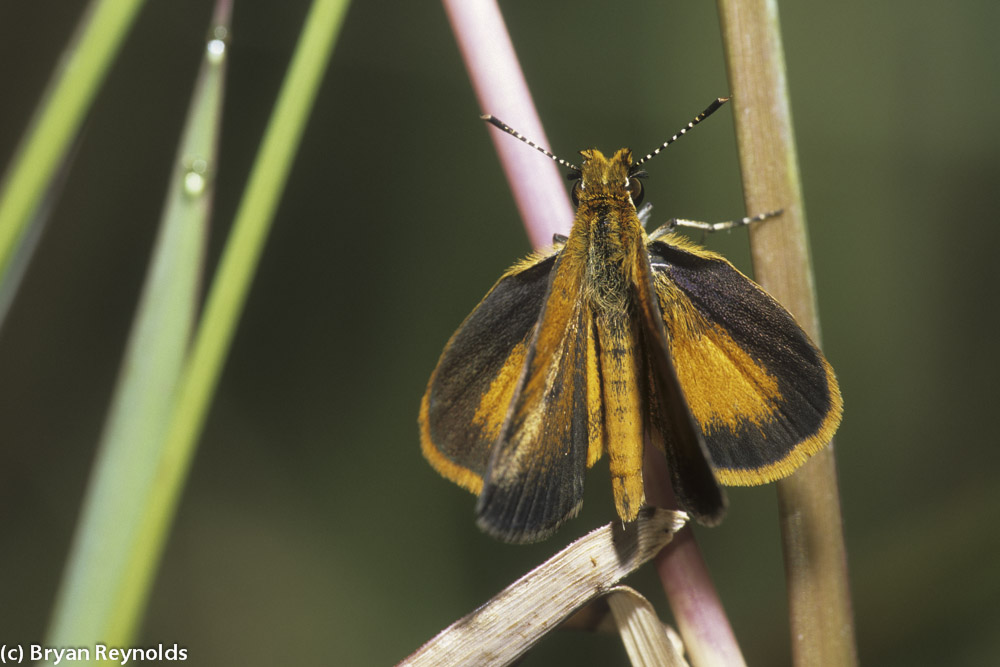

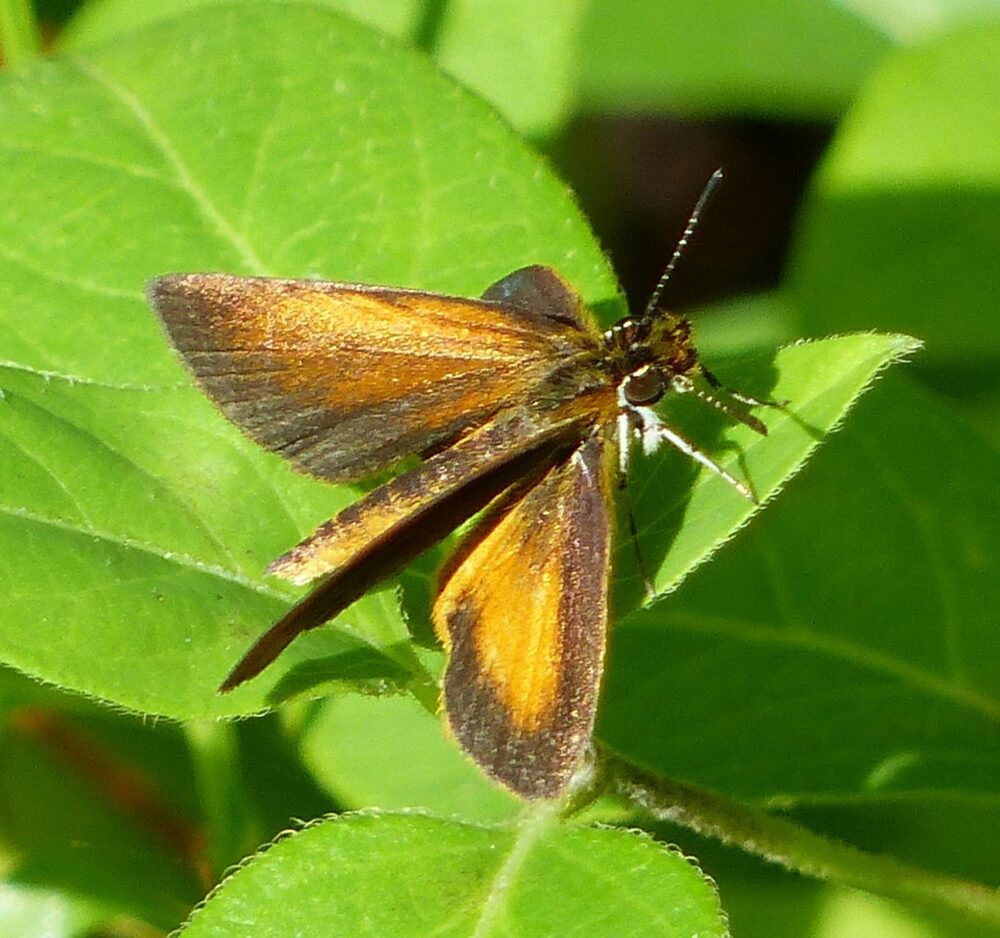
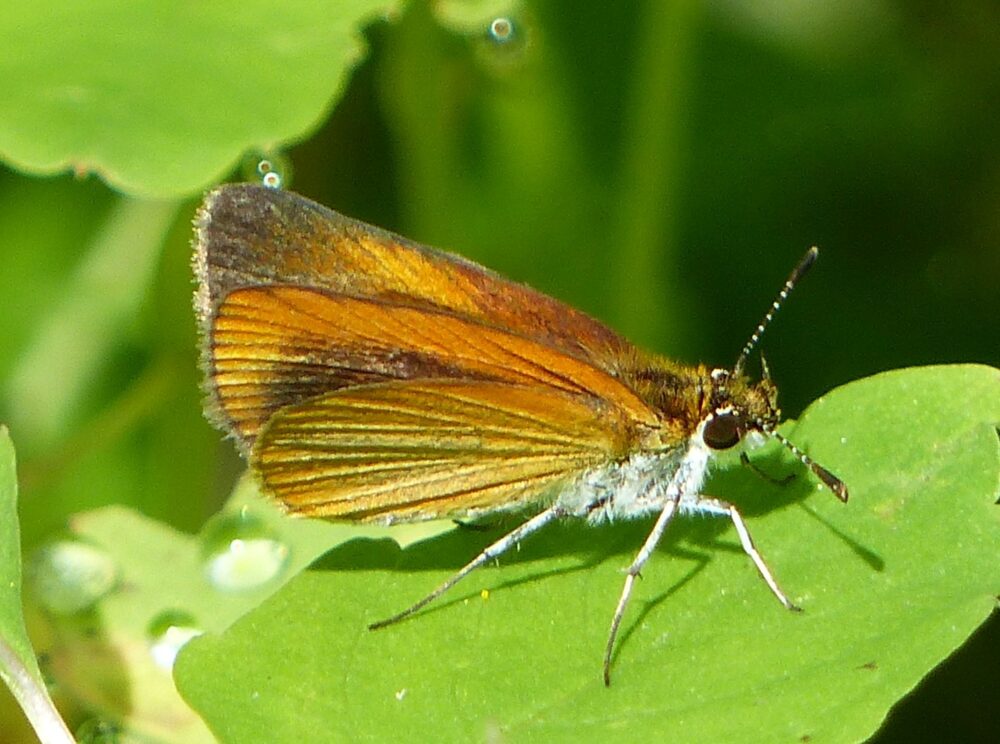
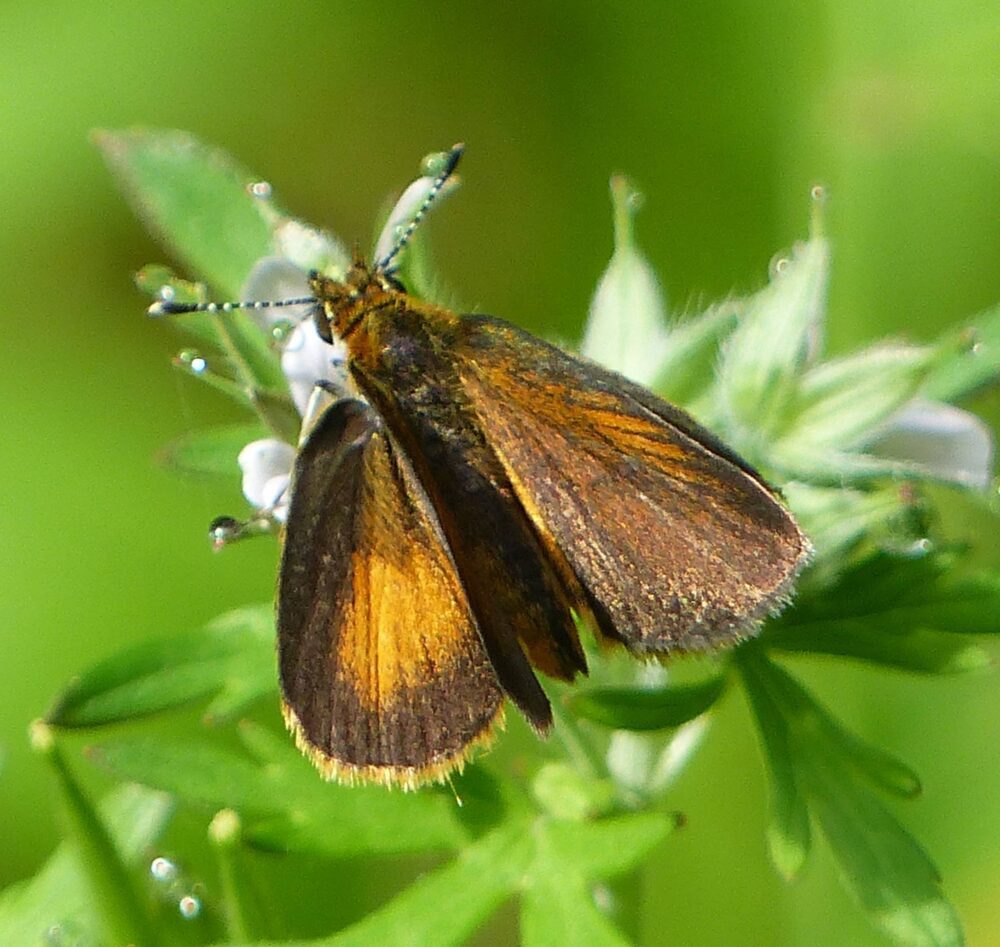
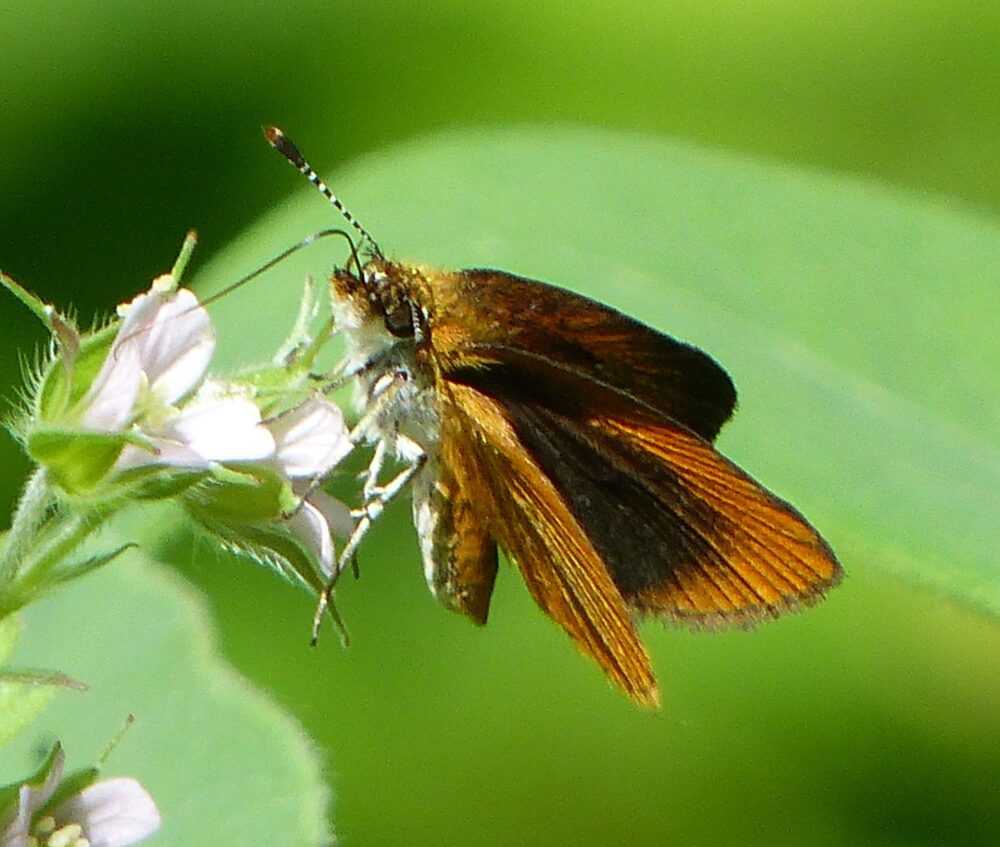
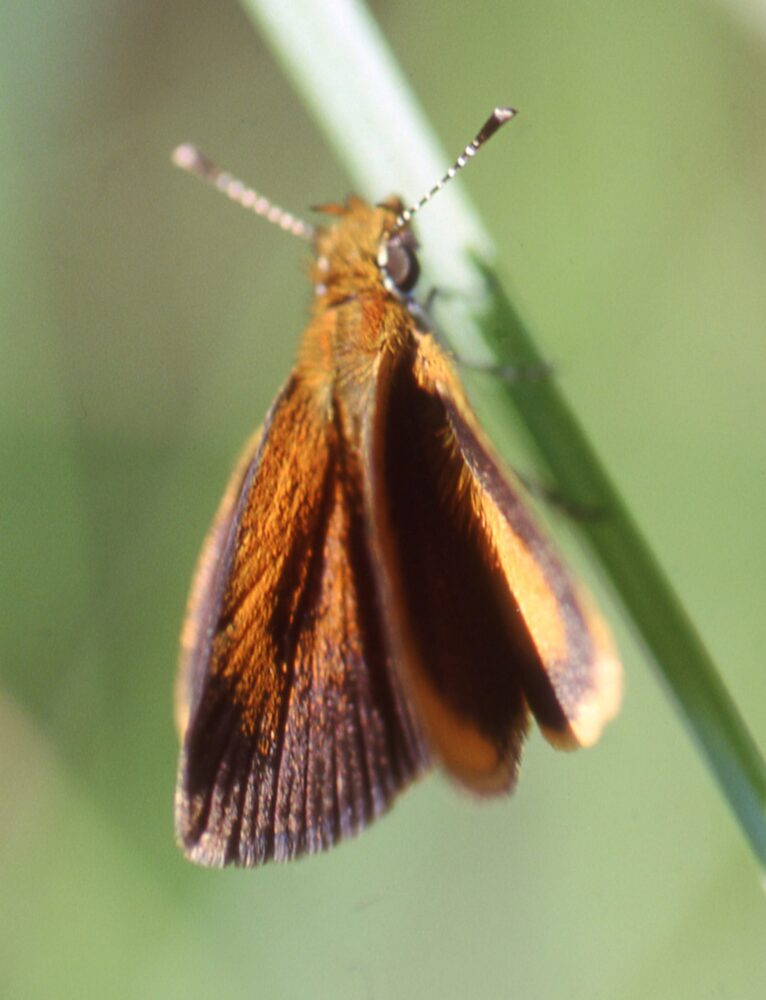

Ancyloxypha arene (W. H. Edwards 1871) Tropical Least-Skipper (updated October 15, 2025)
Description. Yet another tiny, orange skipper, Ancyloxypha arene has a tawny orange underside with pale veins that terminate at faint dark marginal dots. The hindwing above is orange with a dark costa; the forewing upperside is orange with a black border. Wing apices are rounded compared to Orange Skipperling and other similar skipperlings. Like Sunrise Skipper and Southern Skipperling, a pale ray runs from base to apex through the VHW cell on some individuals, making identification of this skipper even more difficult. Perhaps behavior and habitat are the best clues: this species flaps low and slow among streamside grasses. Range and Habitat. Tropical Least-Skippers live from Central America north to southern Arizona, south Texas and southern New Mexico (counties: Be,Ca,Ch,DA,Ed,Gr,Gu,Hi,Lu,Ot,Sv,Si,So,Va). In our state this species prefers grassy riverbanks below 5600′ elevation. It occurs along banks of the Rio Grande and irrigation ditches in southern New Mexico. Life History. Larvae eat Echinochloa crusgalli, Polypogon viridis, Polypogon monspeliensis, Leptochloa panicea brachiate, and Paspalum distichum in southeast Arizona (Bailowitz and Brock 2021). Flight. Adults fly weakly among riverside grasses. Records from March 27 to December 5 depict a spring flight followed by overlapping summer and fall broods. The seemingly feeble flight of Ancyloxypha species distinguishes them from Oarisma and Copaeodes species, whose flight is much more brisk and purposeful. Comments. Ancyloxypha arene was first documented in New Mexico by virtue of a specimen at the Allyn Museum of Entomology, taken near Redrock, along the Gila River (Gr) on 8 October 1937.
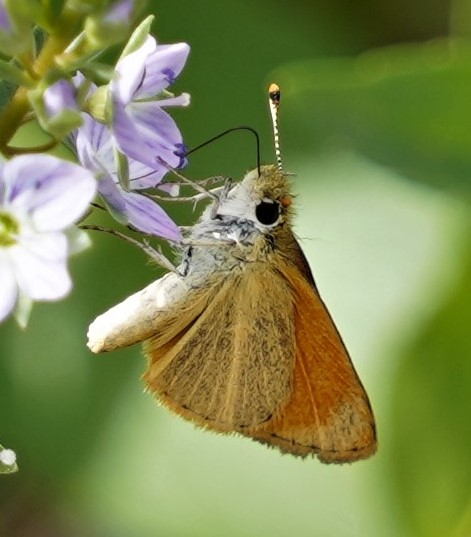

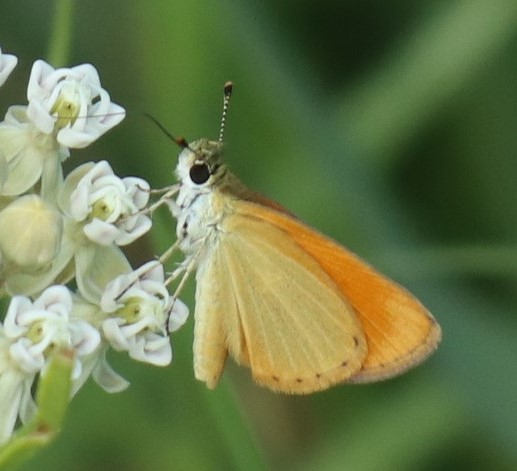



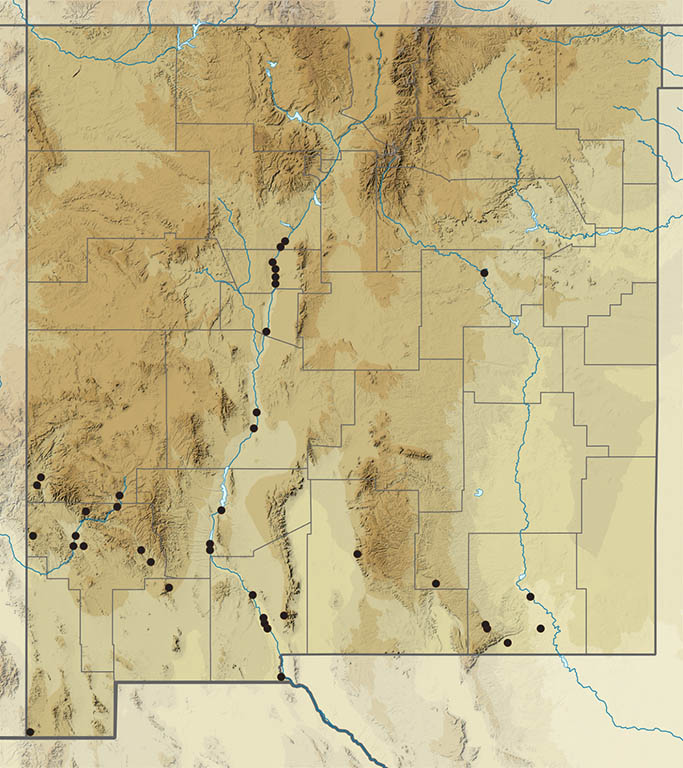
Adopaeoides prittwitzi (Plotz 1884) Sunrise Skipper (updated October 15, 2025)
Description. Sunrise Skipper is the rarest of our tiny orange skippers, at least in New Mexico. It is distinguished by black scaling along the upperside forewing veins from the margin inward. It also has a pale band running from base to margin of the hindwing below. Range and Habitat. Adopaeoides prittwitzi is distributed from central Mexico northward, barely entering the US in southeast Arizona, west Texas, and southwest New Mexico. AS far as we know, New Mexico colonies occur only along the lower reaches of Cloverdale Creek and Clanton Draw in the Animas Valley (county: Hi). Look for it in adjacent slack-water streamside habitats below 5200′ elevation. Life History. Paspalum disticum (Poaceae) is reported as a larval host in southeast Arizona (Bailowitz and Brock 1991). Flight. Adults patrol weakly over host stands and rarely wander from marshy habitats. There appear to be two annual flights: spring brood records span May 20 to June 22; our sole autumn brood record is September 24. Comments. This skipper was first seen in New Mexico by legendary prolific southwestern lepidopterist Kilian Roever on 22 June 1991.
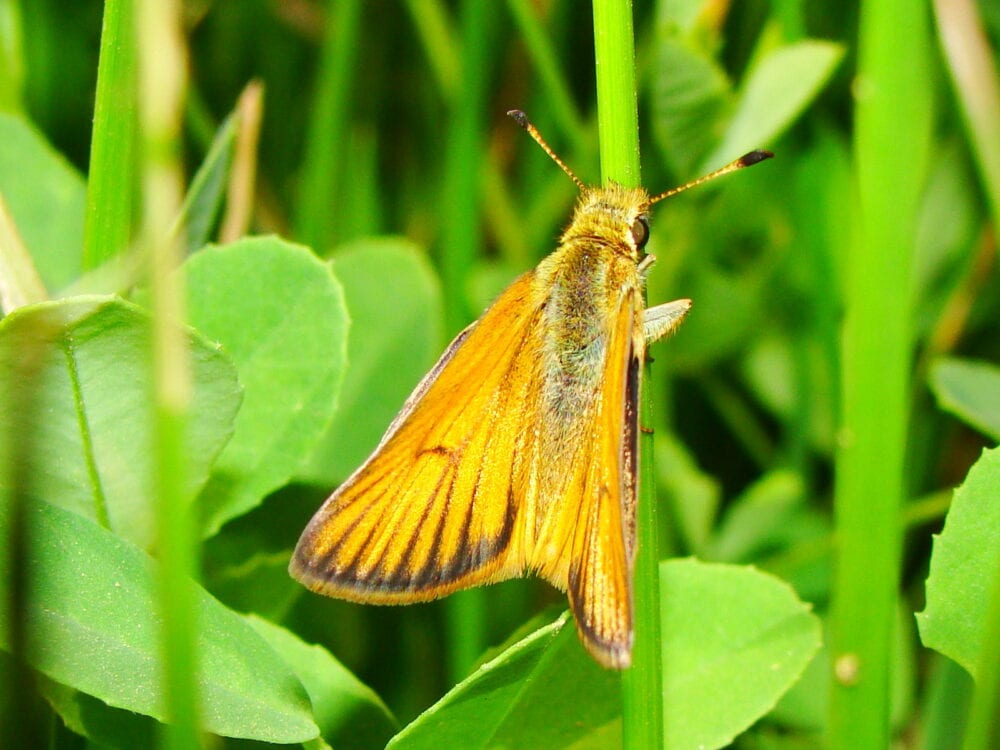

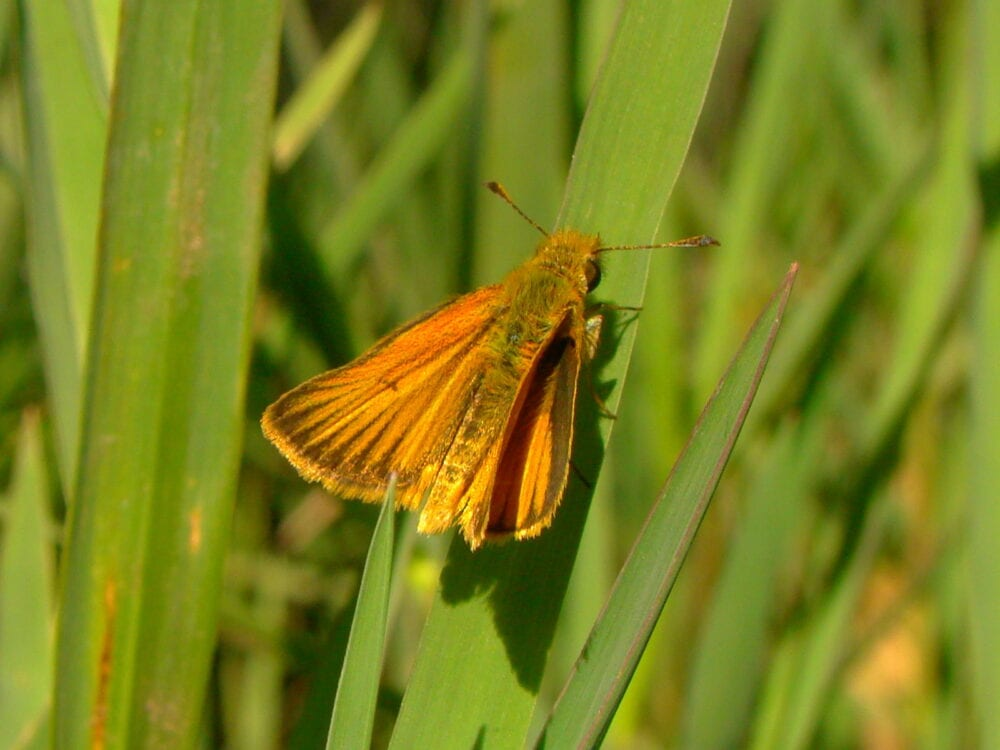
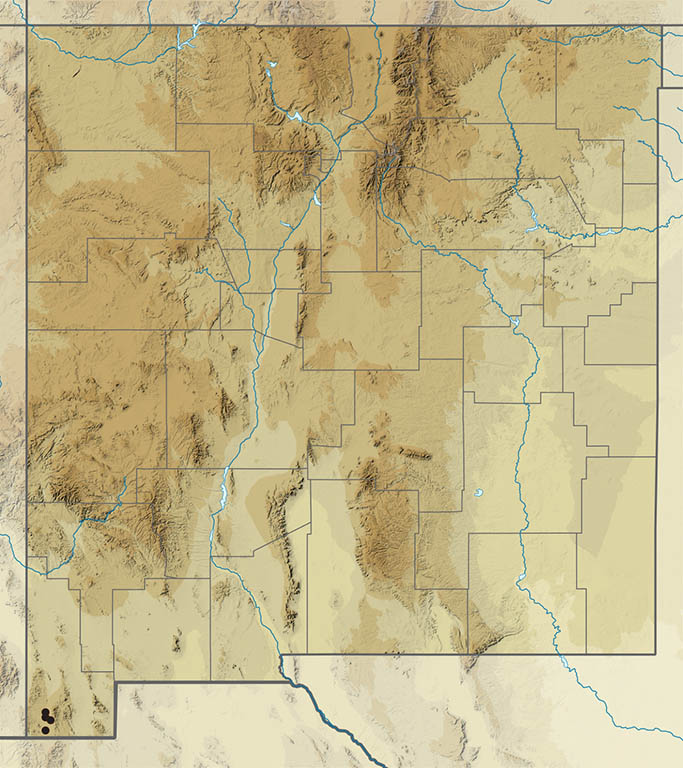
Panoquina ocola (W. H. Edwards 1863) Ocola Skipper (updated October 16, 2025)
Description. The distinguishing characteristic of this smallish skipper is the elongated narrow fore wing, extending beyond the hind wing when the wings are folded. The dorsal surface is dark brown with translucent pale spots on the fore wing (no cell spot). Ventral surfaces are variable; most are brown with a purplish sheen which may pale as the individual ages. Some have a definite orangish cast. Range and Habitat. A very common skipper along the Gulf and Atlantic coasts in the SE US, straying much farther north and west. In the SW US, it is a rare stray. Life History. A number of grasses are known as larval hosts elsewhere, including rice and sugar cane. Hymenachne amplexicaulis is also used. Flight. In SE AZ, records range from August to October. A similar range of dates is to be expected in NM. Comments. This skipper, a rare stray to the southwest US, has been found on the AZ side of Guadalupe Canyon. It will eventually be found in NM, there or elsewhere in the border country.
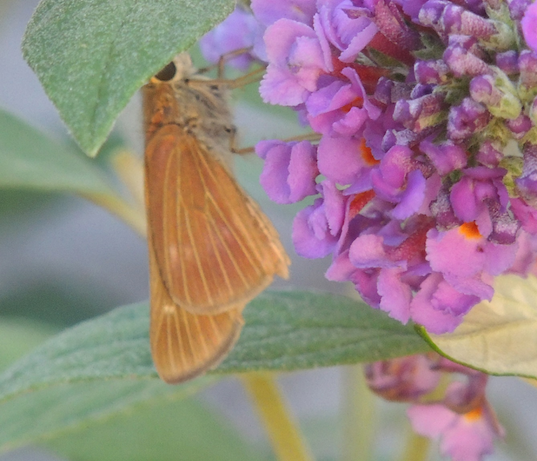

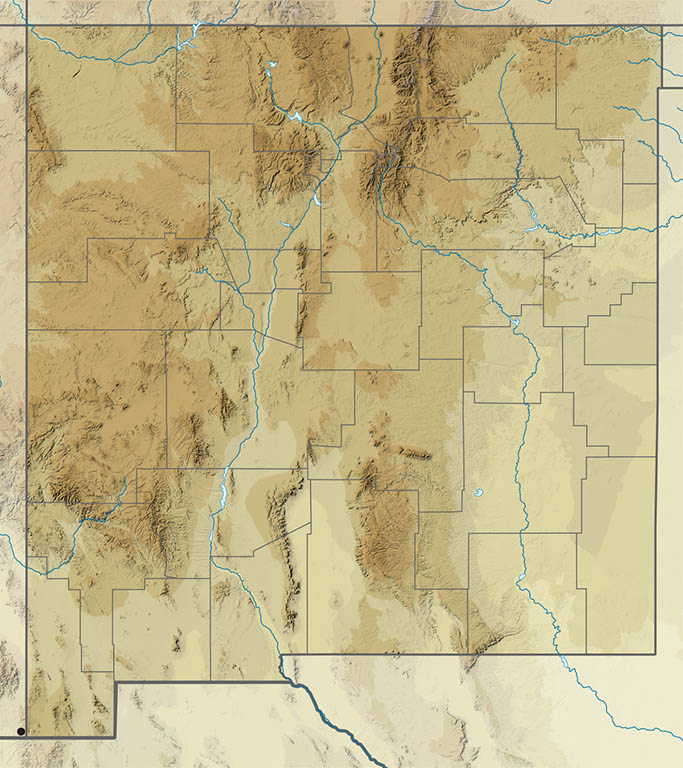
Synapte shiva Evans 1955 Faded Faceted-skipper (updated October 15, 2025)
Description. The Faded Faceted-Skipper is distinctive, as US skippers go, though south of the border this would not be the case. Our species has a dark brown upper surface with a prominent postmedian row of orange-yellow spots. There is a rounded spot at the apical end of the FW cell, and an orange dash at the upper margin of the cell. Females are somewhat lighter in appearance dorsally. Beneath, the hindwing is distinctively marked with a golden-brown ground color and darker brown striations with a darker brown triangle midway on the costal margin. The ventral forewing is a paler reflection of the dorsal surface. Range and Habitat. This tropical species typically ranges from western Mexico to Nicaragua. It rarely strays north into southeast AZ and southwest NM (county: Hi). In its normal habitat, it prefers forest edges and light gaps in the forest. It comes to nectar and moisture. Life History. Bailowitz and Brock (2021: 278) indicated that hosts are grasses in the genera Urochloa, Lasiacus, Setaria, and Couinia. There is no evidence of reproduction in NM. Flight. There is one May record from AZ; otherwise, all known observations span August – November. Comments. Our sole record is a specimen captured by Kilian Roever on 23 October 2006 approximately 32 miles south of Animas (Hi). Previously considered a subspecies of Synapte syraces (Godman 1901), shiva was recognized as a distinct species by Warren (1998, 2000).
